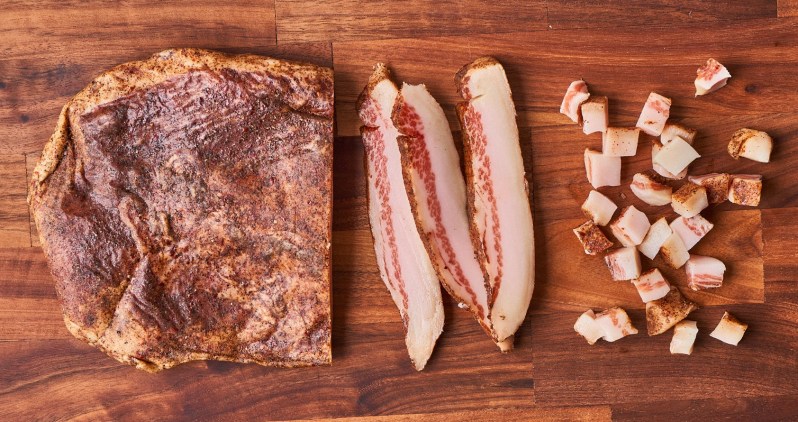
There’s no denying that bacon is still the leading contestant in the food popularity pageant. Everyone loves it, and for good reason. Sure, we may have gone a bit overboard in our passion for this delicious cured meat, putting it just about everywhere, in every dish imaginable, making novelty gifts and board games in its honor, led by our passionate infatuations. And who can blame us? Bacon is delicious. There’s no getting around it. But maybe, just maybe, it might be time for bacon to at least share the spotlight with a lesser-known but equally delicious cured pork delicacy – guanciale.

What is guanciale?
Guanciale is a type of cured meat that comes from the cheek of the pig. The word “guanciale” stems from the Italian word for jowl, “guancia.” This particular pork cut has humbler origins than other cuts that come from the pork belly, such as bacon or pancetta, but its wonderful marbling and equal distribution of fat give it a beautiful tenderness that other cuts don’t possess.
Salty and meaty, guanciale’s taste is similar to bacon or pancetta but with a finer, more complex flavor and a rich balance of sweet and savory notes.
Is guanciale different from bacon?
While these two cuts of pork are often used interchangeably in recipes, there are some very considerable differences between guanciale and bacon. As previously mentioned, they come from very different sections of the pig. While guanciale comes from the jowls, bacon (and pancetta – another delicious and comparable pork cut) comes from the pork belly.
Also, bacon is generally smoked and used in dishes that are complimented by that signature smokiness. Guanciale is not smoked and, therefore lacks the charred, campfire taste that bacon has. Guanciale is also far saltier than bacon, which makes it better as an ingredient and not as a stand-alone snack.

How to use guanciale
While guanciale isn’t necessarily a piece of meat to enjoy on its own, this delicious ingredient works in an enormous variety of dishes. Its umami sweetness is often accentuated and complimented with an assortment of spices that include some variation of salt, pepper, garlic, rosemary, and sage.
Recipes that call for guanciale
Of course, this incredible Italian ingredient can be tossed into just about anything for an instant, delicious upgrade. Mix it in just about any salad or pasta dish for a savory addition that’s unparalleled in flavor. Dice it into small pieces and serve atop seafood dishes like clams or oysters for a wonderfully savory accent to the crisp and cool brine of the sea. But of course, as the ingredient is Italian in origin, it is most popularly used in pasta dishes.
There are many traditional Italian guanciale pasta dishes, each one absolutely delicious, accented by guanciale’s signature meaty, salty flavor. Some of our absolute favorites include:
- Pasta alla Gricia – While this dish may be rustic and simple in its preparation, it is certainly not lacking in flavor. This traditional Italian dish features pasta, Pecorino Romano, black pepper, and guanciale and sings in its simplicity.
- Amatriciana – This tomato-based pasta dish includes an assortment of vegetables, cheese, and guanciale and is a dish that is beloved throughout Italy and the rest of the world.
- Carbonara – Perhaps the most famous guanciale dish, pasta carbonara is a creamy and rich delight with its simple egg yolk and cheese sauce, accented with tender, savory bites of guanciale.
Our favorite guanciale
If, at this point, you’re wondering where to buy guanciale, we have the answer: Fra’Mani.
Fra’Mani guanciale
Fra’Mani, the country’s most decorated producer of salami, cooked salumi, and smoked sausages, is an award-winning, Berkeley-based company that’s dedicated to doing things the right way.




